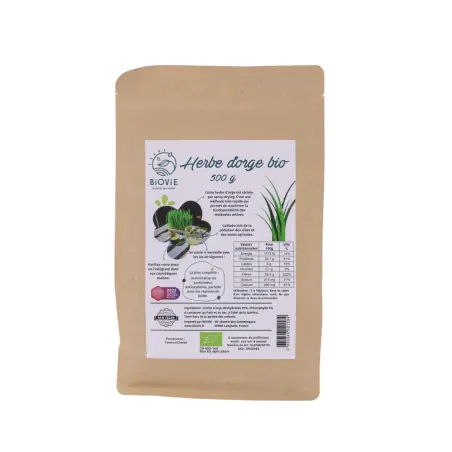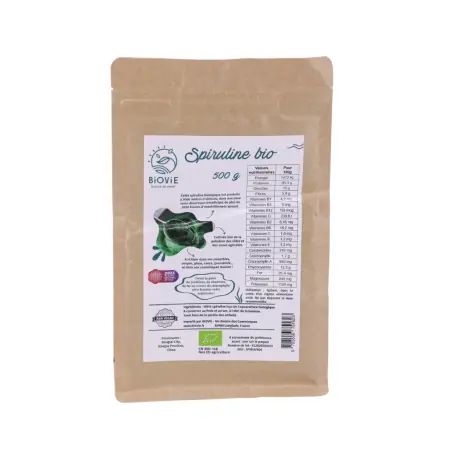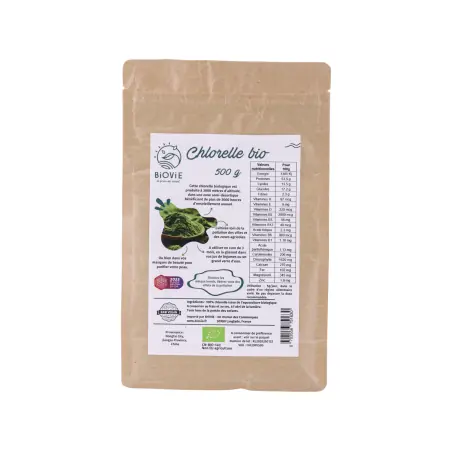The chlorophyll, Commonly referred to as the "green blood" of plants, it is much more than just a pigment that gives plants their green hue. It is also a vital component essential for photosynthesis and crucial not only for plant survival but also for its positive impacts on human health. Among the numerous scientific studies conducted on this green pigment, chlorophyll is recognized for a multitude of benefits, ranging from blood detoxification to the prevention of various diseases, thus distinguishing itself as a beneficial and indispensable element for health. This article analyzes ways to incorporate chlorophyll into our daily lives to optimize overall health, thereby creating a link between human well-being and the planet's natural resources.
What is chlorophyll ?
Chlorophylls are the primary assimilative pigments of photosynthetic plants. These pigments, located in the chloroplasts of plant cells, play a role in photosynthesis by capturing light energy, which is the first step in converting this energy into chemical energy. Their absorption spectra of light radiation are the reason for the green color of plants; the wavelength that is least absorbed is green, and this color is perceived in the light reflected towards the eye by the leaf.
Chlorophyll assimilation is the active assimilation of carbon dioxide through photosynthesis using chlorophyll. This photosynthetic agent is actually a biological process that converts light energy into chemical energy stored through the action of chloroplasts containing chlorophyll. Chlorophyll synthesis is the most common form of photosynthesis.
Dr. Wattenburg from the Faculty of Medicine at the University of Minnesota demonstrated that when rats were fed a diet containing all known vitamins and nutrients, but in a highly purified form at 50-75% as is the case in our modern diet, these animals were no longer able to produce certain enzymes whose role is to neutralize carcinogens in the liver. However, when the same rats were given portions of greens, they were able to produce these enzymes. The compound present in leaves and plants that ensures this capability is called "indole" and is also found in thewheatgrass.
Different herbs, or green plants, contain liquid oxygen that is useful for digestion and brain function; and they have an action against the proliferation of cancer cells, as the latter can only survive in the presence of oxygen.
Different herbs and green plants contain several hundred enzymes that significantly contribute to their exceptional nutritional value due to their chlorophyll. To combat cellular oxidation, it is necessary to provide the body with antioxidants. (like vitamin E, C, selenium), as well as antioxidant enzymes (like SOD, catalase, peroxidase, glutathione).
Biochemical reminder about chlorophyll
The green pigment of the plant (chlorophyll) which is produced by photosynthesis is a concentrate of sunlight, and therefore represents life energy. In a spiritual sense, the sun is the symbol of wisdom. (light) and unconditional love (heat). It is undoubtedly no coincidence that the color green is associated with the heart chakra, which is one of our main energy centers.
Photosynthesis allows plants to produce sugar. (fructose) from atmospheric carbon dioxide and water. In a plant, chlorophyll is used to store the energy from the sun, which then allows the plant to generate new organic syntheses necessary for the plant's life process.
The researcher Halima Neumann claims that chlorophyll is the only substance that can transfer the sun's energy, which it has stored, through the food we consume.
The green part of plants is composed, among other things, of fragments of light-harvesting particles, the phycobilisomes, which contain small amounts of lipids, and even more so, proteins, chlorophylls a and b.
In phycobilisomes, chlorophyll is associated with proteins. (such as phycocyanins). Chlorophyll has the ability to convert carbon dioxide into oxygen, promoting better oxygenation of tissues and thereby stimulating all forms of healing. It is particularly recommended as a major adjuvant in all pathologies related to cellular asphyxia.
The chlorophyll of thebarley grass or of wheat For example, it has the same molecular structure as blood hemoglobin, with the only difference being that the central molecule is composed of magnesium instead of iron.
Iron-based preparations are often ineffective because copper is essential for the assimilation and storage of iron in hemoglobin. For blood production, certain elements are necessary. "elements" including 1 iron ion, 1 copper ion, 1 potassium ion, and 1 protein.
In addition, folic acid (or vitamin B9) is essential for blood formation. If there is a deficiency of copper or iron, for example, anemia will develop.
On the other hand, chlorophyll, due to its unique chemical composition, even when isolated, stimulates the production of hemoglobin and red blood cells. According to Binet and Stunza (Research on anemia provoked, experimental therapeutic trials, In 1937, anemic rabbits whose diet was supplemented only with chlorophyll, without any copper or iron, regained a normal red blood cell count in 14 days thanks to this particular regimen. Other experiments conducted by researchers Bereskov, Petrvas, and Isotfva (in 1980) ;Levshin, Kelentri, Fekete Kun (in 1958), and Sofonova (in 1965) confirmed the use of chlorophyll against anemia, emphasizing that when bioavailable iron is added, the results are faster.
Studies have shown that the chlorophyll contained in plants (as thebarley grass or of wheat for example) increased resistance to radioactivity. In an experiment conducted on guinea pigs that had all received a lethal dose of X-rays, 97% of those that consumed their usual food died within 20 days; 44% of those fed with carrots died within the same timeframe; but none of those that were fed with green vegetables succumbed!
Doctors Rafsky and Krieger have achieved multiple cures of ulcerative colitis through chlorophyll enemas. According to Dr. Caroll Wright (professor of dermatology at Temple University in Philadelphia and Dr. W. S. Morgan (from the same university), Significant improvements or even complete recoveries have been achieved in several conditions, such as internal infections and deep ulcers, various skin diseases, gingivitis, etc., thanks to chlorophyll.
The benefits of chlorophyll for health
- Chlorophyll is beneficial in reducing the production of gases and toxins related to digestion. It can be recommended in cases of strong breath and intestinal fermentations.
- Chlorophyll is a regenerator and a stimulant for the liver. This effect has been confirmed by Dr. Wattenburg. (from the University of Minnesota) and Charles Schnabel.
- Chlorophyll helps neutralize bacterial toxins, including those from Staphylococcus aureus and Clostridium perfringens. It also contributes to restoring the body's acid-base balance.
- According to Dr. Bichet, the chlorophyll present in the juice of grasses and leafy greens improves heart function and has beneficial effects on the vascular system, intestines, uterus, and lungs. According to Dr. Arthur Robinson from the Linus Pauling Institute, the juice of certain herbs and green plants appears to have a dilating effect on the vessels, thereby improving circulation and cell nutrition. When consumed regularly, it helps reduce the incidence of cancer by 75%.
- According to Dr. Chiu-Nanlai from the University of Texas, chlorophyll effectively combats tumors without the need to resort to chemical drugs. An experiment conducted in 1928 by Dr. Charles F. Schnabel of Kansas City Rockhurst College in Kansas City discovered that hens fed with a blood-generating plant material (such as cereal grass) laid a greater number of eggs and lived much longer than those fed with a normal diet. By simply increasing the diet with cereal grass by 10%, egg production increased by 38% to 94% in winter! The eggs were more numerous, the shells harder, and the chicks healthier than those from hens fed ordinarily. Experiments leading to similar results were conducted by feeding the hens with grass sprouts.barley "and of"alfalfa.
- Chlorophyll, through its daily use, helps to optimize numerous biochemical processes in our body and thus represents an undeniable ally in promoting excellent health.
Chlorophyll for healthy skin
Not only is chlorophyll essential for photosynthesis, but it also exhibits significant beneficial properties for dermatology. Due to the richness of this plant pigment in vitamins and antioxidants, chlorophyll extracts are incorporated into various dermatological treatments for their ability to repair and regenerate the skin. These extracts help stimulate the healing of skin lesions and reduce inflammation, effectively treating a variety of dermatological conditions such as acne, psoriasis, and ulcers.
Thanks to its anti-inflammatory effect, chlorophyll possesses intrinsic capabilities that can reduce redness and irritation associated with various skin disorders. By modulating the activity of inflammatory cytokines, chlorophyll is able to soothe irritated skin and decrease the appearance of blemishes and skin eruptions. The antioxidant components of chlorophyll protect the skin against the assaults of free radicals, as by neutralizing these chemically unstable entities, it helps to preserve skin youthfulness and delay the onset of aging signs.
Chlorophyll helps facilitate tissue regeneration and accelerate the wound healing process. It is particularly effective in treating minor cuts, burns, and abrasions, and in promoting quick and efficient skin healing. It purifies the skin through its detoxifying properties, thereby reducing the frequency of acne breakouts and other dermatological disorders associated with the accumulation of harmful substances.
How to incorporate more chlorophyll into your diet ?
The increase in chlorophyll intake is associated with the multiple health benefits we just mentioned. Here are some simple and effective ways to incorporate more chlorophyll into your daily diet:
- Increased consumption of leafy green vegetables: Plants such as spinach, rocket, kale, and the leaves of mustard, are substantial sources of chlorophyll. Incorporating these vegetables into your salads, smoothies, and various prepared dishes can increase your daily intake of chlorophyll.
- Green juices and smoothies: "La" juice preparation and smoothies are a very effective way to consume a significant amount of chlorophyll daily. Combining green vegetables with fruits can enhance the taste and optimize the nutritional benefits, as demonstrated by a smoothie made with spinach, cucumber, green apple, and lemon.
- Use of fresh herbs: You can add herbs such as parsley, cilantro, basil, or mint to your recipes, which can increase the chlorophyll content. These herbs can be added to salads, soups, and even drinks.
- Algae and microalgae: "The" seaweed "and" microalgae, "notably" the spirulina "and" the chlorella, are classified among the superfoods the richest in chlorophyll and other essential nutrients. The spirulina is distinguished by its blue-green hue due to the chlorophyll and phycocyanin it contains. This microalgae is a complete source of protein because it contains all the essential amino acids, and it is also rich in B vitamins, iron, magnesium, potassium, and calcium.
On his/her side, the chlorella is characterized by its high concentration of chlorophyll, the highest among all known foods. It is rich in proteins, fibers, and vitamins such as vitamin C and those of the B complex, as well as minerals like iron and zinc, and omega-3 fatty acids. The Chlorella is particularly valued for its ability to bind heavy metals and other toxins, thereby facilitating their elimination from the body. These microalgae can be consumed in various forms and easily integrated into the daily diet, such as powders of spirulina "and of" Chlorella which can be incorporated into smoothies and juices, or used as a seasoning on dishes. Tablets or capsules offer a convenient alternative for those who prefer a more direct and preparation-free option. This way, you can fully benefit from these microalgae and their abundant resources in chlorophyll and other vital nutrients.
Conclusion
In conclusion, chlorophyll proves to be a true green treasure for human health. Its richness in vitamins and minerals makes it particularly beneficial for improving our overall well-being. This green pigment offers detoxifying, anti-inflammatory, and antioxidant properties that can protect the body against various diseases and accelerate healing. Incorporating chlorophyll into your diet can be a simple and effective strategy to reap its numerous benefits. Chlorophyll continues to live up to its reputation as a green treasure and its status as a valuable ally for our health, acting as a bridge between the benefits of nature and our daily well-being.



















